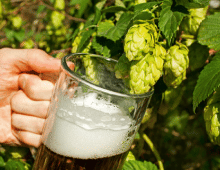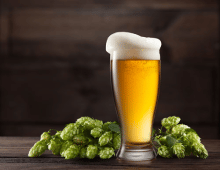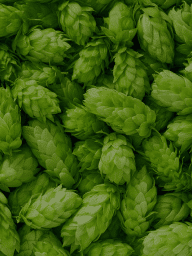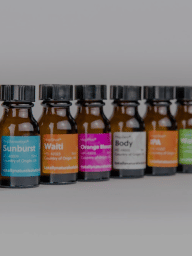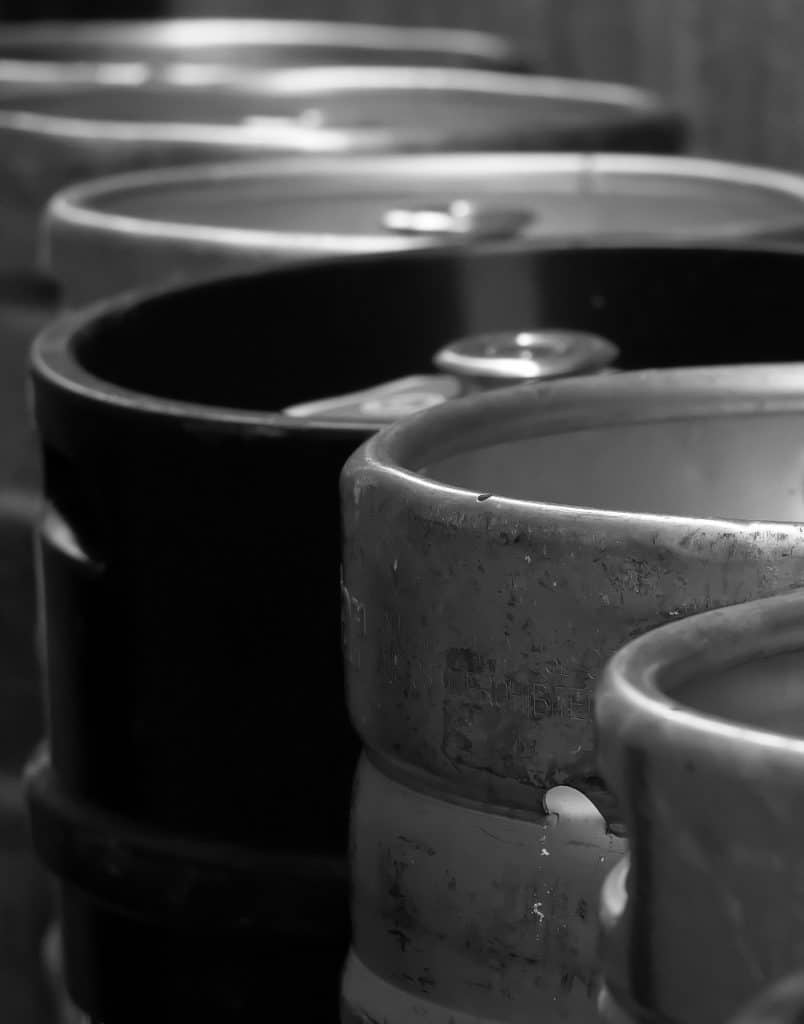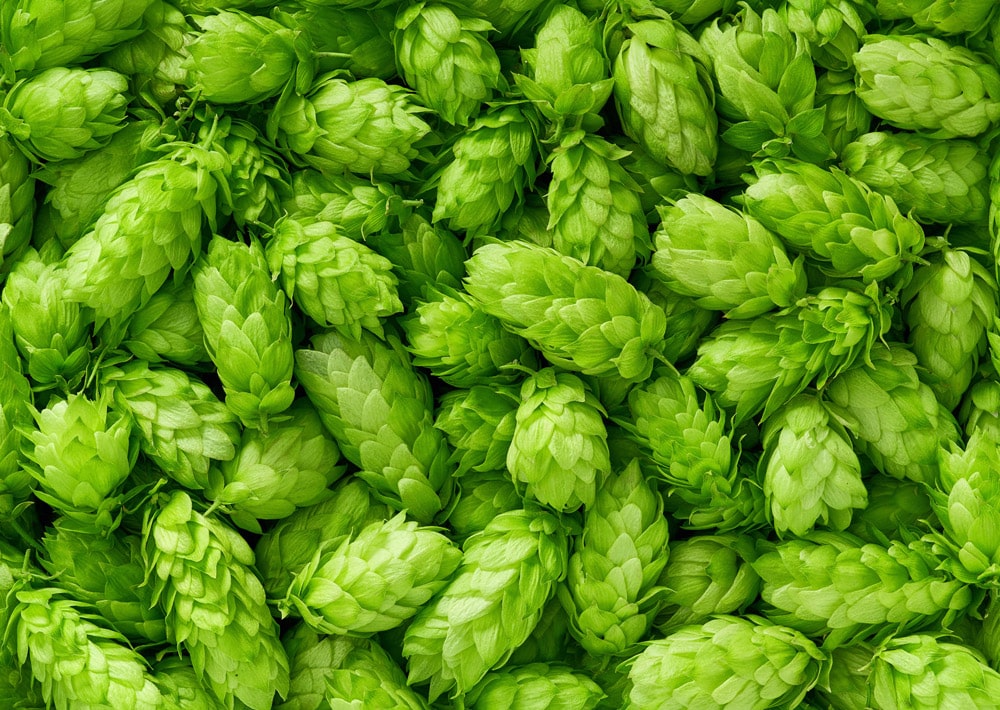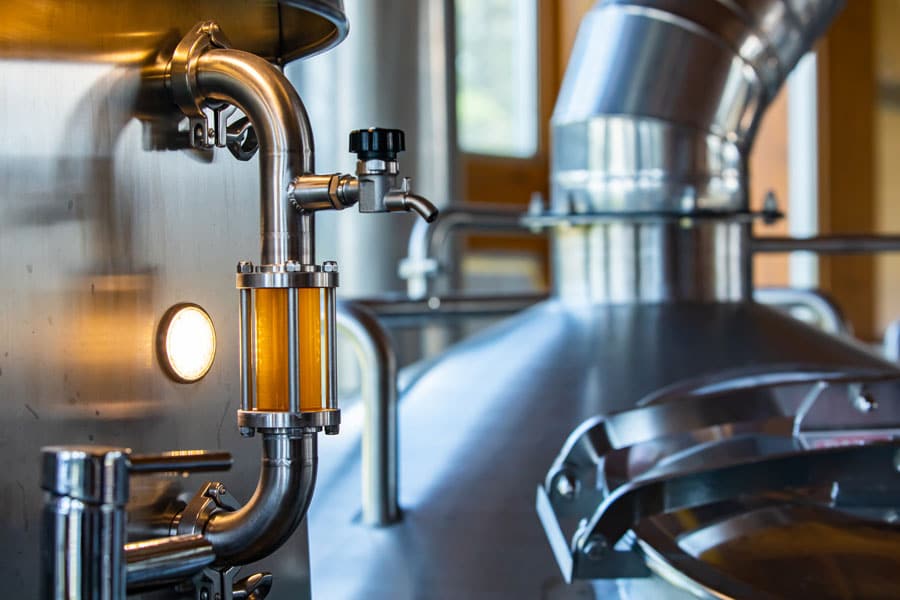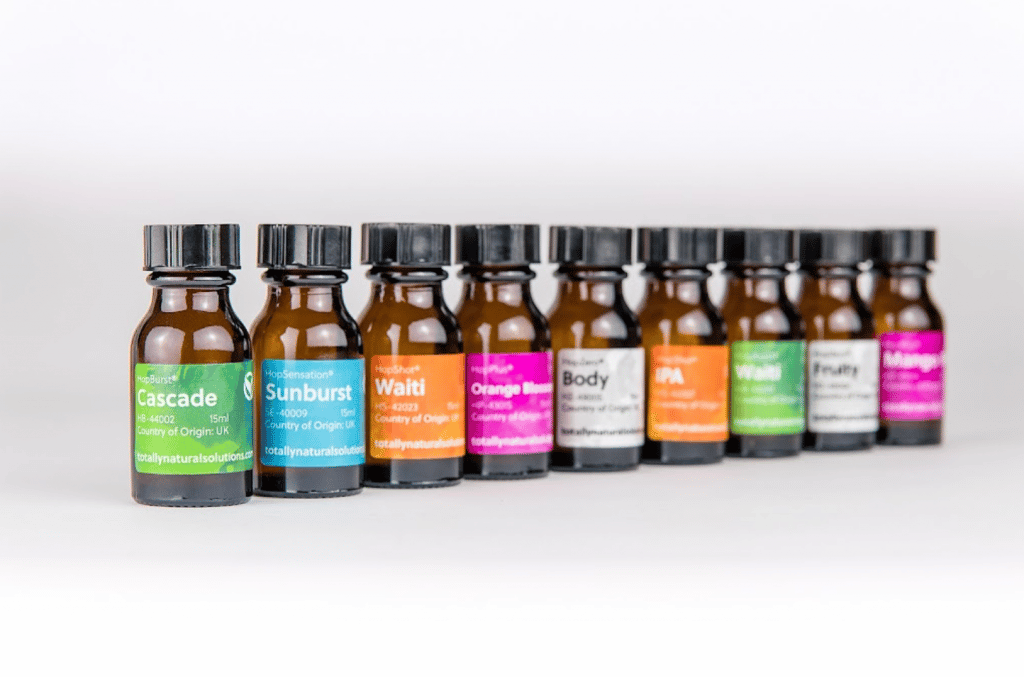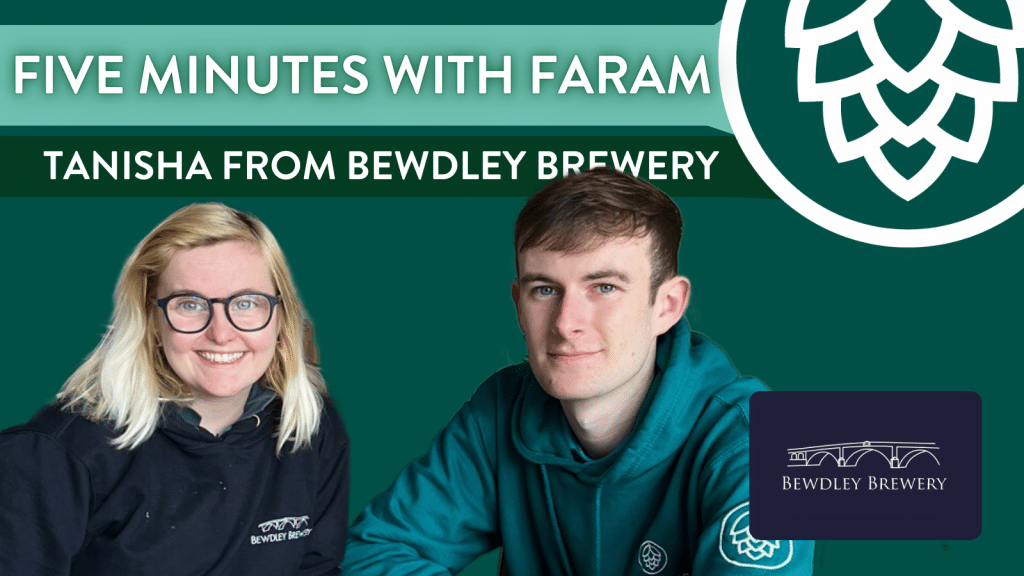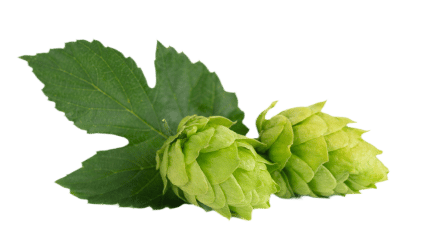Ep 30 - It's the Weyermann® Way: From Recipe to Refinement
WHAT COULD YOU LEARN WITH WEYERMANN® IN THIS PODCAST...
This Weyermann ® Malt Podcast is also available on:
Get ready for malt to take the spotlight on this week’s episode of Spreading Hoppiness. We welcome malt expert Axel Jany from Weyermann® Specialty Malts, all the way from Germany. He sits down with our own brewing expert Faram’s Jon and Beer Writer Mark Dredge to chat about the world of malt and its impact on your beer.
From the heritage of favourite varieties such as ISARIA 1924® to developments in CARARED® and CARAHELL®, they cover it all, exploring flavour, colour, and taste along the way. With Jon revealing what unique tweaks you need to make to take your beer to the next level.
But that’s not all! Join Paddie for an exclusive interview with Bewdley Brewer Tanisha, from creating can artwork to find inspiration from her cat, Tanisha brings creativity to every part of the brewing process.
Need more detail about the Weyermann ® Malt Podcast? Check out the main points below:
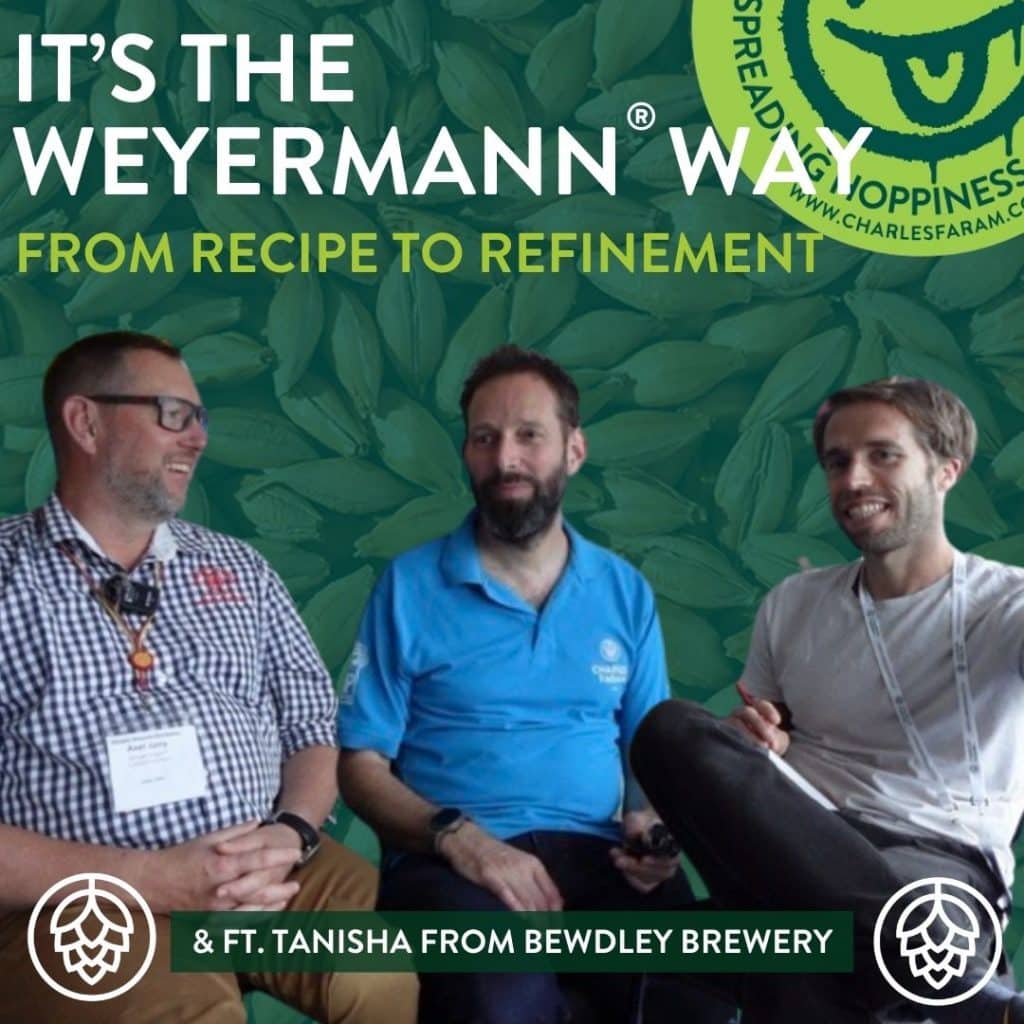
Patrick Whittle 0:05
Welcome back to Spreading Hoppiness, the Charles Faram podcast. This week, you join Mark Dredge our own Jon Stringer and Axel Jany from Weyermann® specialty malts together, they take you on a journey of flavour and technique, from supple recipe tweaks to inventing a whole new beer.
Jon Stringer 0:21
I’m Jon Stringer. I’m Sales Manager for the South East and East of England for Charles Faram. And prior to that, I was a commercial Brewer GADD’s Ramsgate Brewery for 9 or 10 years. And that’s me. So
Mark Dredge 0:37
I’m Mark Dredger a beer writer.
Axel Jany 0:39
Hi Mark, Hi Jonn. I’m Axel. I’m Axel Jany from Weyermann® in Germany. I’m also a brewer and maltster, and my role at Weyermann to travel the world and brew beer.
Jon Stringer 0:49
So Weyermann® have been working with Faram for quite a long time, and the quality of the malt that you produce is fantastic. Looking at base malts. There’s, there are a number of different base malts that Weyermann lager, base malts that Weyermann produce. And I was looking for some information, really, about sort of, maybe differentiating those base malts say like Barke® and Pilsner, the Pilner malt and Isaria. Where’s a really good fit for each of each of those sort of base malts in different styles?
Axel Jany 1:26
Yeah, as you say. Weyermann® we call ourselves Weyermann® Specialty Malts. And base malts, per se, by name, are not very special, but with the additional influx on flavours and taste by using base malts produced from heirloom varieties, old varieties like the one you mentioned before, Barke® or now our latest, being Isaria 1924 is the oldest tall spring barley variety of Germany, and we brought that back. The same goes with the Terroir base malt from Italy. It’s Eraclea, and these base malts are a great addition for the true style, for example, Italian Pilsner. By brewing this with an Italian barley grown at the Adriatic Sea and having special brewing properties, giving a crisp flavour on a hot day, you know, you don’t want the 100% maltiness of the German heavy base. You want something that delivers a crisper, more refreshing flavour, like on that Italian Eraclea, the Isaria, for example, being 100 years old. If you want to do a fest beer, if you want to do a Munich style fest beer in the old tradition, colour wise, it is almost more like a Vienna malt, because the grain itself is tends to be darker and the kernels are smaller, yet the taste is incredibly dense and almost nutty like and so this is a twist to recipes and which require maybe just base malts, but yet you’re differentiating with the aromas and flavours that you get.
Jon Stringer 3:12
You mentioned is Isaria. Are there any considerations that the Brewer has to take into account for mashing or anything like that? Is it just as easy to mash as the standard Pilsner lager?
Axel Jany 3:24
Good question. Good question. I think it is as easy to use as a modern variety, because the malting process will, you know, get into the modification and all of that. As I mentioned earlier, the kernels are smaller because the size of the grain was smaller back then. And obviously this is the push of all the barley breeders to bring varieties that have more kernels per acre and more yield on the field. But that does not necessarily mean it is the most flavourful one, and by bringing the old versions back, or the old varieties, and giving a farmer, of course, a compensation for it, yeah, because they are being paid by the tonne. But if, if they grow our old varieties, it’s that mutual trust that we have for them and have that agreement that we will get these kernels.
Jon Stringer 4:19
Yeah, we were talking a little bit earlier about the floor malting side. Weyermann® acquired the floor molting. How many years ago was it 5/10? Years ago?
Axel Jany 4:30
yeah 10, I think. Could it be even 2011 I think so. Time flies at 13 years now. Yeah, and yeah, that was our floor malting facility is in the Czech Republic, and we’ve been there and it was not used. And we thought, wow, coming from our mindset of specialty malts and that passion for creative beers, we thought, why don’t we bring that floor malting base malt back? And. We teamed up with the malster, or the brewery there, and revived the whole malt House Floor malting, and it’s been a success ever since.
Jon Stringer 5:09
Fantastic, and you seeing that maybe trending, that more brewers are wanting floor malted, or
Axel Jany 5:13
It is certainly a grain that you would use in style. I don’t see a floor malted IPA. This is not why we would use floor malt, but for example, from not using any floor malt. Now in the Czech Republic, I’d say 95% of all our breweries in the Czech Republic have at least one of their beers produced from floor malting, because it just fits nicely into their heritage. And also, when you think floor malting means it is no artificial aeration, the germination takes place on the natural environment. There’s no artificial cooling. There’s not a fan running. So that base malt, if you sample it, and if you smell it, there are so much more volatile aromas still in the kernel that you will not find on a modern produced malt, because there you have a much larger layer and more air being pushed through. And that’s the reason why in a beer like a bohemian Pilsner, that’s shine through that grassiness, and these, these light, fragile aromas, which would otherwise be gone.
Yeah I think that flavour element is really important, but also the story as well. So the idea that we’re going back to these important traditions of malting, I think there’s something more tangible to brewers nowadays to understand that actually this is, this has a bit more to it. But are you also using some of those heritage malts or heritage barleys in this floor malting process? Or what barley is you using for that?
No, that would be a modern bohemian barley variety. It’s the good that’s a good thing to say. Okay, let’s go and floor mold one of the old Czech varieties, but we have not done that. Good idea
Jon Stringer 7:08
Looking at recipe formulations, certainly for pale lagers. Obviously lager malt, you know, you Pilsner malt or your Barke® would be the the base of the recipe. But there are little tweaks you can use for maybe colour or reinforcing the foam. And then there’s a few, I’ve looked at some Weyermann recipes, and there’s a few little things that are used. Sometimes there’s a bit of Carahell® used, or maybe some Munich, depending on the colouration, or maybe the tone of the malt profile you want to give to the drinker. Is there any other sort of, like little things that you use for predominantly pale based lagers?
Axel Jany 7:53
Well, if the pale base, you could also, if your emphasis on this on an extremely pale then you could go extra premium pale Pilsen, you know. So that is the lightest colored Pilsner we make. So it’s a modern variety, but where the emphasis is really on no colour increase, you know, the mildest possible, or the lightest colour possible, and then a bit of addition of viscidulated malt, for example, on lager beers to watch out for. The pH is of importance, because the right pH will give you better yield, better protection against oxidation in the mesh, so So you’re sort of reducing the risk of browning and keep that fresh when the pH is lower. And for that reason, of course, you guys can also use, you know, lactic acid, but it is a gentle way of using natural acidified malt, and it pays for itself, because there is a better yield also coming.
Jon Stringer 8:56
Yeah absolutely one tip I remember you giving me would have been around smoked malt. And most brewers, unless they’re actually going to deliberately produce a smoked beer, they won’t touch it. Yeah, but I’ve been using it in all the lager brewing I do at home, now, whatever style of lager it is, even pales, I’ll use 5% of the beach, the Beach, Smoked pale malt. And it really does ramp up intensity of the malt character. It’s incredible.
Axel Jany 9:27
Yeah, indeed, that is something that our junior boss, Francesca, she had this in her master thesis as well at university at Weihenstephan, and she was looking into the flavour impact of below threshold smoke malts in beers, and it is like a flavour enhancer, and we usually say in the malt bill, above 25% then a normal customer would detect smoke aromas, but below, if you don’t say it, then you don’t really detect it. But then you have this round effect. You’re having more depth, not necessarily maltiness, but it just gives a rounder it pushes. And also did a recipe with a fest beer where the 10% smoked malt was counterbalancing caramel notes in a very positive way, because sometimes you think, if it’s too much caramel, it hinders the flow, because you think, Oh, it’s a little bit on the thick side, and by having the 10% smoke, it toned down the caramel, but you still had this beautiful copper coloured fest beer. And so, and nobody was scared. So it’s because it is always a bit like us brewers thinking, Oh, smoke, beer is cool, but it usually translates harder into sales behind the bar. You know, people are either loving or hating it, but you need a certain education and being brought into it more gentle, I think. And so, yeah, as I said, it’s a smaller portion, and it’s great to hear that you’re using just we also have a very pale summer beach lager beer, and it’s also very refreshing, and on live beers. It’s quite unusual, because the two main brands of the most famous Ralph beers from Bamberg are dark, and so by having a light beer with smoke aroma, it’s a unique thing.
Mark Dredge 11:33
I think this is really interesting, because I think when people do think of Bamberg, they just have this idea of Schengen Metz and like this strong, dark, rich beer. And then we think, Okay, well, smoke malt, its only application is making a smoky beer, yes, and probably a dark beer. But I think it’s really interesting that the flavour enhancement that you can have from smoke have you kind of linked into that? We’ve talked about lagers using smoke malt. Have you used that in any ales?
Axel Jany 12:06
Yes. Well, yes, we’ve got beautiful recipes for a scotch ale. We call it Under the Kilt. That’s the beer, and it’s been really nice. We’ve done a smoke bock beer as well. Well, that is lager, but we also did a smoky pale. We call it so we’ve just as you know, we have brewery at Weyermann with where we research and development and brew every day, and all of these recipes are available to customers. So reach out, and I’m more than happy to send you all of the smoke recipes or what else you need, but it’s a great especially on the scotch ale with with a bit of smoke, not too much. But this is the same thing, you know, you have usually a lot of caramel character in the darker Scotch ales. And by having that smoke it, it’s a good combi
Jon Stringer 13:00
Looking at the specialty grains, and maybe the scotch ale had red hues, and it did. It was melanoidin is an amazing malt. I’ve used it in my professional past for not only really, really sort of creating malt complexity in sort of british ales. But also I’ve used it from a colouration point of view. So if you’re trying to produce a red beer, it’s an absolute key component. I think I used it with some Extra Pale Pilsner Malt, maybe a little bit of tweaking with some CARAFA® just to sort of like take the tip the color down a little bit. It’s a great malt. I think more British brewers should be looking at some of these things, because British Maltsters produce a lot of great malt, but there’s some bits that Weyermann® do that I don’t think the British Maltsters do. So can you talk a little bit about the process of making melanoidin?
Axel Jany 13:58
Yeah melanoidin is the darkest malt coming from the kiln. So all of our caramel malt come from our caramelisation or roasting drums, you know, depending on how you run him, if you caramelise or we roast, but it’s the same rotating roaster. But melanoidin comes from the kiln, it is the darkest one. And melanoidin malt has a lot of Maillard products by having the germination done at higher temperatures and less oxygen in the germination box. So you’re sort of like, you know, keeping it on recirculation. So the Co2 that is being produced by the grain by breathing, is kept inside, and so that enhances the Maillard reaction, special selection on the grain, if it has now, this would be one where you would like to have a little bit more protein, because that is exactly that’s the precursor there. And so that is the reason it’s quite a in the early days, when you would not have roasters at hand, where you have a precise facility to caramelise. The Maillard reaction was the only option the brewer, the maltster the head to increase colour and flavour in the base malt, not base malt, but in a normal malting process. And and it’s, as you say, it’s good for, for flavour complexity, for depths, colour wise, in combination with some CARARED®, also, it’s, it’s a bit misleading, CARARED® as a name is, yes, it is used in red beers, but itself, it might be a tad bit too orange, and the combination with the melanoidin, you’re getting the colour more towards the red,
Jon Stringer 15:53
Yeah, talking about that family of products, CARAPILS®, CARAHELL®, CARARED®. I don’t, I don’t see many brewers in the UK, certainly using CARARED®. And maybe it’s, I think it’s the word hell is obviously aligns beer style. The hels because it’d be a natural fit for adding a little bit of golden colour and reinforcing the foam stability. Yes, is there any other sort of styles that can be used in possibly hefeweizen. And would you use it in something like that?
Axel Jany 16:20
You could with, I usually compare it and say, CARAPILS® and CARAHELL® are the two technical malts that enhance foam stability, as well as adding dextrins Or having more dextrins in their sugar range. So you are keeping then, or you’re adding, harder to ferment carbohydrates, and then you have a more residual sugar in your beer. So where you have a like, you want a strong backbone, a flavour, this is where that would kick in. And the CARAPILS®, you’re just having a lighter color. We try to be that, you know, so and in the CARAHELLundefined, despite the name hell of light is darker in color, and you would use that more towards recipes where you don’t need a light coloured base, and also in some strong beers and stouts, could also be a possibility o add.
Mark Dredge 17:19
So I’m interested in trends of sales. So have you noticed any particular types of malt increase in sale in the last five or 10 years?
Axel Jany 17:32
Oh, that’s that’s hard to say, because we export in 136 countries. So 136 countries are getting Weyermann® malt. And there are trends that are internationally, but then there are also local trends. So I cannot pinpoint one malt and say, Yeah, this is the key. I mean, there are best sellers like our CARAFA® special. You know, nobody does such a nice, gentle, consistent, dark malt with that gentle flavour, because of our dehusking process, that’s why we call it special, or CARAFA® special, that’s always been a safe, solid product SINAMAR®, our all Natural malt colouring that is definitely a very popular product throughout the world because of its natural production. As you know, you could use sugar, colour, you know, in to make beers or beverages darker, but yeah, they are not clean label. You would have an E number on the label. And by having our all natural SINAMAR® that is just nowadays more in a trend of a healthy beverage. So that’s that’s one, and certainly, as we’ve said earlier, the heirloom varieties where the customer has more emotional connection he wants to drink a bohemian Pilsner with the Bohemian grain or a fest beer with a traditional malt that is also on, internationally, on the rise. But in general, I think we have a trend towards lager beers. Craft beer is more and more lager beers, from IPA to lagers, because brewers are now having the equipment, the facility to store beers for longer and and it’s a Brewmasters prior to to be able to make such a lean beer, we cannot hide much into it. So this is one thing, and dark beers, I think stouts and porters are also throughout the world popular on rising at the moment, Maybe also because of texture, you know, a little bit easier on the on the palette, a little bit more residual sweetness than the traditional stouts, maybe. So that’s what we see.
Mark Dredge 19:54
I really like the brewers. One, making more lagers, but two, also interested. In having more traditional ingredients to make them. It’s not just, Hey, let’s make hella. So let’s make pearls. It’s, let’s do it. But then let’s be as German as possible about it, or as Czech as possible about it. Yeah. If you want to make a true as true possible German Hellas as you can if you’re not in Germany, then what can you do? You can bring in the hops. You can bring in, yeah,
Axel Jany 20:21
And this works the other way around as well. I mean, Sam Smith’s beers are so popular in Germany and in Europe, you know, for their styles of, you know, traditional English.
Jon Stringer 20:31
You were mentioning dark beers, and we mentioned CARAFA® as well. And CARAFA Special is amazing, and it’s soft and smooth and lends itself really well to things like Schwartz beers and good brewers in the UK using it for maybe some stouts, maybe stouts that they don’t actually want the roasted barley harshness and porters. One other product that Weyermann® do, which I don’t think gets a huge amount of traction, you might be able to correct me on that, is chocolate wheat. That’s a great product. And I know that some brewers in the UK have been using it in things styles like black IPA. Is that something that it’s a reasonably new product, isn’t it as part of the range?
Axel Jany 21:11
Yeah, it’s not one that I would say, oh, it’s new. It’s been been around, and it’s certainly like when I have visitors and we sample all the fresh roasted malts. It’s definitely one of the favourite ones. By tasting it, it is so nice. It’s also the CARAWHEAT®. You know, the caramelised wheat is a great product. Both would work very well in cereal. They are very pleasant. I totally agree. But you’re right. It’s a bit like you have specialties, and there are some niches you know, which are discovered by brewers, but not on such a big scale, but it’s definitely if I would brew a dark wheat beer, for example, or, like you say, the wheat addition, why not substitute a little bit from in a stout with something like that? Because, as we all know, I mean, wheat gives a different texture and more depth in it. So that definitely good.
Mark Dredge 22:09
Just have one more question. It’s about your small brewery that you have on your facility. You say you’re brewing on every day. Can you just tell me a bit about what you’re brewing, why you’re brewing? There things like that.
Axel Jany 22:21
Yeah it is a 2.5 hectoliter Casper system. The brewing manufacturer caspers is also in Bamberg. So of course, it’s a natural way of saying, Yep, let’s, get one of the local breweries to be installed. It’s actually our second one. We then moved the first one to our Brazilian distribution partner, and the second one, it’s just fully automated, 2.5 hectoliter system, but not because our brewers are lazy, but often we develop recipes for breweries where we just change slightly the malt bill, but we want to run them on auto so that, you know, you know, thinking, Oh, I should have sparged 10 minutes ago. So let him run and then compare and say, okay, the addition of 1% CARAFA® tastes better than 2% and stuff. You know, that was the only reason why it is fully automated. But Constantine and his team, we have two brewers. Costantine is a brew master and two brewers, and always one apprentice and usually guests from around the world brewing with us, maybe for a day or for a week or months internships. And the reason why Weyermann® is doing this is because we want to see how our malts are performing. It is our hands on quality control, because we brew with our products every day, but we also use it for recipe development. Every recipe that we create, it stands for customers, so it’s not except if we do a special recipe for one customer, then that is theirs. But the ones we brew on a day to day basis, once it’s an established, nice recipe, it’s either on our website or people are calling us and say, oh, I want to do a Berlina Weiser. And then I would send at least three different recipes and then give a little bit of a, yeah, look. This is the traditional one, this is one with natural food edition here and there. And that gives the brewer, as you know, like they can look at it and say, yep, I like him, or no, mine is better. And what they do with it, it’s their decision. You know, I will not say, Look, this is the ultimate one. No, it’s not even this is the beauty of us being brewers and being creative. And everybody can can say, oh, yeah, I want rather this malt added or not, because it’s you are the cook at that moment, but that’s a great way to stay in contact with customers around the world. That’s why we brew. We don’t want to become a competitor. I mean, we have two, I think two restaurants in Bamburgh have our beers in one shop, and of course, in our visitor center, we sell our beers. But this should be it. You know, we we will be happy to supply malt around the world, but not beer.
Mark Dredge 25:06
I think that’s a brilliant service, because if a brewer is looking to make a new beer style, if you can say, hey, look, we’ve got proven recipes. Here’s two or three of them. Have a look. These are the kind of the grains that we think work. These are the temperatures. These are the processes. And you can look at that, and then you can say, okay, for me, I think I like, I think some of this, some of this, and we’ll work out.
Axel Jany 25:27
Exactly that’s, that’s the key, yeah, and, and we not only do this on beer, we also do this on whiskey. We have our own whiskey distillery, because specialty malts and whiskey are a different subject, but a beautiful addition into single malt whiskeys. And so we do that also on site. And if you see our historic malt house in Bamberg, it’s definitely a place for brewer to spend a day and explore and to taste all of the products.
Mark Dredge 25:57
Yeah, it’s a fun place to visit a theme park for beer lovers.
Jon Stringer 26:03
I’ve got one final question. And then it goes back to base malt again, which we were discussing at the start. A lot of brewers in the UK probably view base malts as being just pale ale malt to a lager, lager malt. You can use other malts as base malts, such as Vienna malt or Munich malt in certain cases.Could you explain maybe some of the styles that you could use those particular base malts in?
Axel Jany 26:30
Yeah, as you say. I mean, back in the days when there were not that big variety, it was Pilsner malt, because that was the base malt for the Pilsner but Vienna was the base for the beers brewed in Vienna. They were a little bit more reddish, more copper coloured. It was just that the malt store in Vienna would do that in a way that they had Vienna malt. And interestingly enough, that was phased out. Vienna malt was not available for very, very long time, and it was just Brewer saying, looking at books and saying, look the old Vienna style lagers. They were more of that fresh copper colour. How can we get this? And then we looked into ways how to get this back into portfolio. And Munich malt was the base mode for Munich dunkel. It was the normal base for these beers brewed back then. And as you say, we would consider them as a base malt, Vienna in Munich for these styles, maybe Vienna lager. But for example, we have a beautiful recipe for Vienna lager. But in addition to the base of Vienna of about 90% a little bit of CARARED®, and like the before mentioned, point 5% CARAFA® Special, that was the key that we didn’t. Did win, for example, world best Vienna lager one year in a competition. It’s just this little complexity adding, rather than saying, I’m not, I do like the idea of single hop or single malt, but realistically, it’s, it’s a bit
Jon Stringer 28:10
You can do. I think you can do a little bit better, a little bit of effort
Axel Jany 28:13
Exactly, exactly,
Jon Stringer 28:15
Subtle additions of this and that can really add dimensions, indeed, to a recipe I brewed a baltic porter quite a long time ago, commercially, and that would use Munich Malt as a base malt. It was a wonderfully complicated beer that finished quite reasonably high gravity wise, because I guess there’s less enzyme in the ash tunnel, possibly to get through everything or create more fermentables, but it completely suited the style,
Axel Jany 28:50
exactly I was just saying, rightly so, because that baltic porter, the residual sugar, or the higher or the less attenuation at the end, the final gravity, if that is higher, that suits the baltic porter very much so because of its texture, as well as that sweetness in the baltic porter I expected. And you’re right, by having this as a Munich, you are already having a little bit less overall enzymes available, and that helps to stay within that spec. And it’s not getting too dry.
Jon Stringer 29:21
No, it’s not, good brew.
Axel Jany 29:26
Now you make me thirsty.
Jon Stringer 29:28
Thanks just thank you very much indeed. Axel for making the journey over here and being a source of knowledge and help to us at forums for many years. And so thank you for coming over and being on this podcast, and thank you, Mark as always, for your insight and your questions.
Patrick Whittle 29:56
Tt’s time for our latest Five Minutes with Faram. You join me, Paddy at Bewdley Brewery, where I catch up with Brewer Tanisha. We talk about all things beer, beer development, and even can design.
Just to start us off with our Five Minutes with Faram segment, if you could just introduce yourself and what brewery will come
Tanisha Bishop 30:16
Okey dokey. So I am Tanisha Bishop, and I’m from Bewdley Brewery. I’m a brewer here.
Patrick Whittle 30:22
Lovely, so how long have you been at Bewdley?
Tanisha Bishop 30:23
I’ve been here just over two years now,
Patrick Whittle 30:28
You enjoying it?
Tanisha Bishop 30:29
Yeah, fantastic. Great fun. It’s nice to be in an industry with more responsibility, because I come from the bar trade originally. So of course, I’ve always had an interest in real ale and anything like that, serving it in the correct ways. And, yeah, yeah, just having an interest
Patrick Whittle 30:45
Serving it’s making it now.
Tanisha Bishop 30:46
Yes.
Patrick Whittle 30:48
So to start us off with our Five Minutes with Faram segment, what’s your favourite hop?
Tanisha Bishop 30:51
My favourite hop, I would have to say, is between Azacca™ and Idaho 7™. And
Patrick Whittle 30:58
Why’s that?
Tanisha Bishop 30:58
They’re just lovely, fruity, tasty hops you can really like, feel the punch of an in beer, and two of the hops that I use to create my beer for the Untapped Apprentice Brewer for the year, so that beer Rootin’-tootin come second place. So yeah, Amarillo®, Azacca™ and Idaho 7™ certainly just absolutely stunning. I’m so proud of that beer. No,
Patrick Whittle 31:21
That sounds really delicious, actually. Yes, you do get those big, punchy flavours, don’t you? And that’s what that’s what my taste palette is too, especially. And I think a lot of people would agree with me on that one those big, like fresher beers, it’s definitely all sorts of coming through, isn’t it? So what would your favourite beer be? Either one you’ve brewed, one for another brewery, or anything really,
Tanisha Bishop 31:41
As for Bewdley, I love the Baldwin IPA. I love Sabrina, which is Wild River, of course, Rootin’-tootin but if I was gonna go step outside, it would be Adam’s dead dessert in a camp. They are absolutely stunning. I really want to make a dessert stout style like it, but I don’t think I can.
Patrick Whittle 31:59
Do you do a lot of experimenting when you’re brewing?
Tanisha Bishop 32:06
We do have a little pilot kit, so at the moment, I’m in the works and trying to dessert stout. It’s just getting those ingredients right, because it’s a beer that we’ve never done before. So we’re just keeping experimental and trying to get these flavours that they want. But yeah, it’s always good fun just to, just to play around and see what works and what doesn’t.
Patrick Whittle 32:26
Yeah, no, definitely. So what would you say your favourite like beer and food pairing is?
Tanisha Bishop 32:32
So a fun fact is about the brewery. Last year we won the cheese award. So our beer is best to be served with cheese. I’ll show you that award later on. So that’s something to talk about. But, yeah, you can’t go wrong with cheese.
Patrick Whittle 32:47
No, definitely not stunning. And also, your beer seems to be best for it. So would you say you have a favourite beer destination that could be UK, that could be abroad Europe, wherever, really.
Tanisha Bishop 33:01
So Prague would definitely be top on the list, because some of their beer is absolutely phenomenal. The same Budapest, fantastic. But of course, we’ve got some good, good destinations around the West Midlands. We’ve got some decent breweries, and it’s just fantastic to see like this part of England doing so well.
Patrick Whittle 33:21
Have you got a favourite pub within those?
Tanisha Bishop 33:22
I don’t want to be biased and say one of the pubs I worked in. I do love Weavers Park Lane. My sister manages a pub, Weavers on Comberton Hill Kidderminster, but they have cracking range of ale, like constantly changing. So that’s really that got a nice back wall for craft, etc. So, yeah,
Patrick Whittle 33:22
I think that’s that brings out a good pub, doesn’t if it has a good range, that changes frequently. It allows you to experiment. There’s so many beers in the world, it allows you to try all those different flavours, doesn’t it?
Tanisha Bishop 33:51
Yeah
Patrick Whittle 33:52
And, sort of, I like, to me, like a proper, traditional sort of pub, sort of, quite like, sort of cozy in the winter fire sort of thing, yeah, good food as well. So, yeah, would that be like one of those, like pub you just described as that sort of thing.
Tanisha Bishop 34:04
Weavers, where I used to work at Park Lane, that is like your proper old traditional cozy, probably your Bathams, you got your Enville, you got your Wye Valley and all that sort of stuff sometimes as well. But that’s a proper traditional pub, whereas The Weavers is more of a crafty, funky pub.
Patrick Whittle 34:21
Bit more modern sort of thing. Okay, that sounds good. No. Sounds really good indeed. So obviously, be assistant brewer here. What would you say is a piece of equipment you can’t live without, or something you use the most or in the brewery?
Tanisha Bishop 34:37
Tough question
Patrick Whittle 34:41
I can give you some example answers that we’ve had before everyone so we’ve had, like, anything from like a computer to a calculator over a pen and paper. It doesn’t have to be something that’s we’ve had, like Mash paddle, that sort of thing. It doesn’t have to be something that’s really expensive or really, like, unique to a brewery, so just whatever you use day to day the most.
Tanisha Bishop 35:00
So I guess, yeah, pen, mash paddle. What would you do about and yeast stirrer? Yeah, what would you do about that?
Patrick Whittle 35:08
Probably not brew very good there. So when you are brewing and sort of on your day to day, if you’ve got any like, go to songs, radio stations, podcasts that you listen to out loud or in headphones or
Tanisha Bishop 35:23
So oh, god, that’s a difficult question as well. Obviously, we got all this music on Spotify. You’re listening away. But yeah, picking, picking one song or one artist
Patrick Whittle 35:35
or an album, if that makes it easier.
Tanisha Bishop 35:37
At the moment, I’m quite into my South African music. So probably Jack Paro, because it’s nice, upbeat, just, yeah, keeps, keeps you going, sort of thing,
Patrick Whittle 35:46
I guess, because obviously, brewing got a physical job, you need that sort of upbeat gym motivation music, sort of like, sort of, when you’re doing, like, the real physical, tough jobs, it sort of really helps. And it’s like, power you through, yeah, good answer. Love that so before, obviously you were into brewing, you worked in sort of pubs, yeah, sort of thing serving. So if you weren’t in the brewing industry, what would you do instead?
Tanisha Bishop 36:09
i”d still be in the pubs I imagine. Once a bartender, always a bartender, they say. But um, yeah, I’m glad to be out of the trade because I feel like I’ve got much more responsibility, and I’m growing as a person, instead of just being behind the bar still.
Patrick Whittle 36:38
Do you find you’re more passionate about the brewing side, rather than, like, the sort of hospitality side?
Tanisha Bishop 36:43
I love both. I do. I do miss hospitality, but then I don’t, but it’s nice just to be out the way and just brewing and, you know, just enjoying myself. Got a great little team here. We all get on and have a laugh. So can’t moan.
Patrick Whittle 36:56
Yeah, definitely, I guess when you’re actually behind the bar, you have to put on that, like, customer faced earlier, customer smile, and that, like perky voice, I guess out about you can sit concentrate and like, really, like, don’t have to put a show on for anyone. It’s a bit more comforting in that way, isn’t it? So do you have, like, a big inspiration in brewing, someone that either got you into it, or someone that you, like aspire to work with, or?
Tanisha Bishop 37:21
I fell into this job really, like I said, covid hit. I just wanted to get out the bar trade, and then I worked doing telesales for a month I didn’t like that. I was just at a loose end, then I saw that they advertised a job for an apprentice Brewer. Here, it’s like, what’s the worst that can happen? Got the interview. And they’re like, Yeah, crack on you’ve got it. You’re the apprentice Brewer now, brilliant, cheers. I’ve learned all this stuff so like, so far. And like, just fantastic. I’m so glad this way it turned out me,
Patrick Whittle 37:54
Sometimes things do just happen. If covid would have never hit, you might have just been sort of working in the bar and you might have never found this sort of unloved passion. And it’s sort of, it’s funny how sort of fate takes a turn. I think how, like your own personal choices, like, really change where you are, so that’s really nice. So, and I guess covid would be the reason why you got into brewing I guess.
Tanisha Bishop 37:54
yeah
Patrick Whittle 37:55
Obviously you’ve always had a passion there, sort of serving the beer and that sort of stuff. So that sort of, like, ticks off that question, really. So what would you say, sort of outside of brewing, outside of the bar where, what sort of hobbies and interests have you got, sort of outside of?
Tanisha Bishop 38:31
So I like drawing, can designs like they’re letting me just sit down and draw here. So got my little digital tablets, I can sometimes sit down and do that, which is, which is great.
Patrick Whittle 38:43
Have you done any for the beers that are available now? Yeah, I actually said to Maddie, literally, when we were sat down, just sort of going through, I was like, that’s really cool, genuinely, like, she might even have that video. No, I love that. What you drew that? Yeah, it’s amazing. So obviously, hobby outside brewing is designing cans for beer and what did you have any others? Or?
Tanisha Bishop 39:06
Most of it is just crafting and doing stuff. I’ve got a little tattoo machine at home as well, but that’s not going too far. I’m not going to be a tattoo artist at any point in the future. Yeah, drawing, painting, just making stuff I love, just
Patrick Whittle 39:23
Generally, creating things, like being creative, that sort of thing. So do you have any like, obviously, from that creativity, do you have any like, beer recipes that you’ve created on your own? So you mentioned that award you want? So how did you come up with the inspiration for that?
Tanisha Bishop 39:38
So in the competition, I gave you a spec of what you had to follow. So over 5% certain color, certain bitterness, etc. So I just took like, 5% is a good, good ABV. From here I’d only go too high.
Patrick Whittle 39:55
That was for your competition beer?
Tanisha Bishop 39:56
That was for the competition. That’s what got second place. And. Is basically named after my cat. So I was just like APA and my American Pale Ale cowboys, my cat Rootin’ Tootin’ to it makes sense to draw me cat.
Patrick Whittle 40:13
I love that. No that does show like a really creative mind, actually, and obviously with the designs, that’s another really good one. Now I love that so and so, just a few quick fire questions. Just finish up on our sort of segments. What was the last beer you brewed?
Tanisha Bishop 40:24
So at the moment, I’m currently brewing Worcestershire Way, Sway, sorry. And before that, Seven Side Stout. So I love brewing the stouts, all the malts, so nice
Patrick Whittle 40:36
And Fuggles or Goldings?
Tanisha Bishop 40:39
I’d say Golding, I think.
Patrick Whittle 40:41
And why is that?
Tanisha Bishop 40:43
Fuggles are just your standard. At least Goldings got a bit more of a kick and a punch to it. And we use Goldings much more than we use Fuggles.
Patrick Whittle 40:50
Bit more familiar use of it then. And what’s next for you in the industry?
Tanisha Bishop 40:55
Um, don’t think I thought I had that first carry on people enjoying it. Maybe in a few years, I’d like to perhaps move abroad and go brewing in Asia. That’s the big dream, but it’s just getting out there and finding somewhere. Yeah, definitely, yeah. I love that part of the world. There
Patrick Whittle 41:12
There we go. So that concludes our Five Minutes with Faram segment. Thank you very much.
Tanisha Bishop 41:16
Thank you
MAIN POINTS
Introduction to this Weyermann Malt Podcast and Episode Purpose
– It’s time for malt to take its turn on this Weyermann podcast. We sit down with malt expert Axel Jany from Weyermann Specialty Malts, Beer Writer Mark Dredge and our own brewing expert and technical export Jon Stringer.
Recipe to Refinement
– Trying out a new beer style? Wish to brew something new? Need some help with your recipe development? This podcast is a great place to start… with tips, tricks and brewing techniques this Weyermann podcast is perfect for anyone trying something new.
Malt Varieties
– From base to crystal to speciality they go into depth about which malts are perfect for your brews, and what surprising varieties match perfectly with a range of brews
– What key parts of the brewing process do you need to consider, when using a range of malts.
Tanisha from Bewdley Brewery - Five Minutes with Faram
– Join Paddie for an exclusive interview with Bewdley Brewer Tanisha, from creating can artwork to find inspiration from her cat, Tanisha brings creativity to every part of the brewing process.


